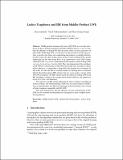| dc.contributor.author | Lombardi, Alex | |
| dc.contributor.author | Vaikuntanathan, Vinod | |
| dc.contributor.author | Vuong, Thuy Duong | |
| dc.date.accessioned | 2021-11-03T15:07:49Z | |
| dc.date.available | 2021-11-03T15:07:49Z | |
| dc.date.issued | 2019-11 | |
| dc.identifier.issn | 0302-9743 | |
| dc.identifier.issn | 1611-3349 | |
| dc.identifier.uri | https://hdl.handle.net/1721.1/137219 | |
| dc.description.abstract | © 2019, International Association for Cryptologic Research. Middle-product learning with errors (MP-LWE) was recently introduced by Rosca, Sakzad, Steinfeld and Stehlé (CRYPTO 2017) as a way to combine the efficiency of Ring-LWE with the more robust security guarantees of plain LWE. While Ring-LWE is at the heart of efficient lattice-based cryptosystems, it involves the choice of an underlying ring which is essentially arbitrary. In other words, the effect of this choice on the security of Ring-LWE is poorly understood. On the other hand, Rosca et al. showed that a new LWE variant, called MP-LWE, is as secure as Polynomial-LWE (another variant of Ring-LWE) over any of a broad class of number fields. They also demonstrated the usefulness of MP-LWE by constructing an MP-LWE based public-key encryption scheme whose efficiency is comparable to Ring-LWE based public-key encryption. In this work, we take this line of research further by showing how to construct Identity-Based Encryption (IBE) schemes that are secure under a variant of the MP-LWE assumption. Our IBE schemes match the efficiency of Ring-LWE based IBE, including a scheme in the random oracle model with keys and ciphertexts of size (formula presented) (for n-bit identities). We construct our IBE scheme following the lattice trapdoors paradigm of [Gentry, Peikert, and Vaikuntanathan, STOC’08]; our main technical contributions are introducing a new leftover hash lemma and instantiating a new variant of lattice trapdoors compatible with MP-LWE. This work demonstrates that the efficiency/security tradeoff gains of MP-LWE can be extended beyond public-key encryption to more complex lattice-based primitives. | en_US |
| dc.language.iso | en | |
| dc.publisher | Springer International Publishing | en_US |
| dc.relation.isversionof | http://dx.doi.org/10.1007/978-3-030-36030-6_2 | en_US |
| dc.rights | Creative Commons Attribution-Noncommercial-Share Alike | en_US |
| dc.rights.uri | http://creativecommons.org/licenses/by-nc-sa/4.0/ | en_US |
| dc.source | Other repository | en_US |
| dc.title | Lattice Trapdoors and IBE from Middle-Product LWE | en_US |
| dc.type | Article | en_US |
| dc.identifier.citation | Lombardi, Alex, Vaikuntanathan, Vinod and Vuong, Thuy Duong. 2019. "Lattice Trapdoors and IBE from Middle-Product LWE." Lecture Notes in Computer Science (including subseries Lecture Notes in Artificial Intelligence and Lecture Notes in Bioinformatics), 11891. | |
| dc.contributor.department | Massachusetts Institute of Technology. Computer Science and Artificial Intelligence Laboratory | en_US |
| dc.relation.journal | Lecture Notes in Computer Science (including subseries Lecture Notes in Artificial Intelligence and Lecture Notes in Bioinformatics) | en_US |
| dc.eprint.version | Author's final manuscript | en_US |
| dc.type.uri | http://purl.org/eprint/type/JournalArticle | en_US |
| eprint.status | http://purl.org/eprint/status/PeerReviewed | en_US |
| dc.date.updated | 2021-04-16T12:36:28Z | |
| dspace.orderedauthors | Lombardi, A; Vaikuntanathan, V; Vuong, TD | en_US |
| dspace.date.submission | 2021-04-16T12:36:29Z | |
| mit.journal.volume | 11891 | en_US |
| mit.license | OPEN_ACCESS_POLICY | |
| mit.metadata.status | Publication Information Needed | en_US |
